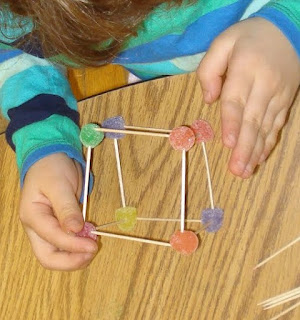After the children gathered on the carpet, I began described what I had observed happening on the playground.
When I call kindergarten to line up at the end of outdoor play, I explained, some children arrive at the meeting place ahead of others. All children do not get in line at exactly the same time. I've been noticing how some children get in line right away if they are close by when they hear me calling. Others playing in places on the playground that are further away need more time to walk or run over to the kindergarten line. Every day the numbers of children in line are different than the numbers of children who are not yet in line. On a day that all kindergartners are present at school, I explained, the numbers always add up to 10 no matter how many students are "in line" and how many are "on the playground."
I acted out the playground "lining up"scenario using unifix cubes. I used a few unifix cubes to represent "kindergartners in line" and others to represent "kindergartners on the playground." I made the groups visible and distinct on the carpet in front of me. "Today," I explained, "Three children were in line ahead of all the others. While they were in line, I counted 7 children who were on the playground." I explained how I noticed that the 3 children in line and the 7 children still on the playground made 10 children "all together." I demonstrated using unifix cubes how the 3 and the 7 equals 10.
I asked the children a few questions about my playground scenario to check for understanding. We reversed the numbers ("Hmmm. I wonder what it would have looked like if 7 had been in line and 3 were on the playground? Can you help me figure that out?") and checked and re-checked our counting: sure enough, our answers equaled 10 every time (3 and 7, and 7 and 3).
I said that I wondered if we could find more "playground stories" that make 10. It seemed to be a very mysterious and most curious question. The children were very eager to try a few playground stories of their own.
I asked the kindergartners to each take 10 unifix cubes to a quiet place somewhere in the room to work on storytelling. They practiced telling number stories using the framework set forth in our previous storytelling. The room buzzed with audible storytelling. I observed many unifix representations of "kindergartners in line" and "kindergartners on the playground." Some children were adding in dialouge, props, and description of specific playground activities.
After 15 minutes of observation and one-on-one conferencing with children as they worked independently, we met back on the carpet to share and record our number stories.
The following represents the number stories related by the children:
Kindergartners in line: | Kindergartners on playground: |
| 7 | 3 |
| 6 | 4 |
| 8 | 2 |
| 3 | 7 |
| 4 | 6 |
| 2 | 8 |
| 0 | 10 |
We acted out the number stories as we recorded them on the chart. After we made the chart, we noticed that switching the pairs of numbers "made 10" every time. We wondered if there are more "ways to make 10" than the ones we recorded today. "Oh, yeah, and what about that day when someone was absent?" a kindergartner remarked as we moved to lunch. "Then we wouldn't have 10. We would have 9. That would be one less than 10, " he said with a smile.
To be continued...










